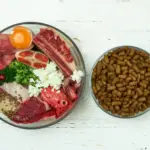If your little guy or gal recently got in the garbage, ate a piece of fatty ham, or has been receiving table food on a regular basis you should keep an eye out for these signs of pancreatitis in dogs.
These are by far the five most commonly seen symptoms in dogs with pancreatitis. If you notice your dog doing any of these things you should get them to a veterinarian as soon as possible!
Pancreatitis in dogs symptoms: Five common signs of pancreatitis in dogs
1. Anorexia
Loss of appetite is a common symptom of pancreatitis in dogs
Anorexia is a loss (or decrease) of appetite and is one of the first symptoms owners notice in dogs with pancreatitis. If you notice that your dog is usually a voracious eater and suddenly has no interest in food no matter how tasty, you may want to see your veterinarian ASAP.
There are two types of anorexia
- True anorexia – This is the type of anorexia seen in dogs with pancreatitis and other systemic diseases. Dogs with true anorexia simply have no desire to eat. You will notice that your dog has no interest in food and may sniff the food but not partake or stay away from their food bowl altogether
- Pseudo-anorexia – dogs with pseudo-anorexia are hungry but they can’t due to something causing difficulty chewing, picking up, or swallowing their food. You may notice your dog returning to their food bowl over and over again but unable to actually eat or whining while at the bowl. This usually occurs with tooth pain, abscesses, gingivitis
2. Weakness
Weakness is the second most common sign seen in dogs with pancreatitis
A lot of owners may notice their dog seems weak and wobbly when they walk or extremely lethargic and does not want to walk or move a lot. If your dog is usually very energetic and bouncing off of the walls and you suddenly notice that he or she is acting sluggish and tired you may want to see your veterinarian.
You may notice that your dog may not want to go for walks or play as much as usual and just laying around the house.
3. Vomiting
Vomiting and nausea may also be seen in dogs that have pancreatitis
If your dog does eat you may notice that they aren’t able to keep any food down and will have vomit that sometimes has whole pieces of food in it.

4. Diarrhea
Diarrhea is a common symptom of pancreatitis in dogs
The diarrhea is usually a darker color but if left untreated it will usually progress to have a light yellow color with a distinct foul odor and a greasy appearance. In addition, you may also notice blood in the stool due to pancreatitis bleeding because of blood vessel rupture.
5. Abdominal Pain
Stomach pain is a very notable symptom of pancreatitis in dogs
Your dog may wince or nip when touched on the abdomen and they may also cry out when picked up by their stomachs. You may also notice that your dog takes a ‘praying position’ which means their rear end is up in the air and their front legs are lowered to the floor.
It should be noted that the combination of these clinical signs could indicate pancreatitis or another illness which is why it is extremely important for your dog to see a veterinarian as soon as you can if you notice any of these symptoms. Usually, the combination of upper stomach pain and vomiting is fairly indicative of pancreatitis in dogs.
Signs of pancreatitis your vet might notice
Your veterinarian may also notice some additional symptoms once presented to the clinic
1. Dehydration
Your vet will probably do a skin tent test and run some blood work to check dehydration in your dog. You can also do a skin tent test at home as well.
A skin tent test is to check your dog’s skin elasticity as when they are well hydrated it is normal. To perform a skin tent test you gently pinch the loose skin away from the body at the scruff and release it. Well dehydrated dogs’ skin will return to normal immediately whereas if dehydrated dogs will form a ‘skin tent’ it will take a couple of seconds to return to normal.
If your dog has been vomiting or has some diarrhea they will most likely be dehydrated as they are losing water and electrolytes.
2. Icterus
Icterus or jaundice is yellowing of the skin due to excessive accumulation of pigment in the blood and tissues. This is usually for prolonged cases of pancreatitis that aren’t treated immediately. You may also notice some yellow tinting of your dog’s eyes and gums.
3. Fever
You can take your dog’s temperature at home as well but part of your vet’s physical examination will be getting a temperature. If your dog’s temperature goes above 102.5 they have a fever (most dogs are under 102.3)


























































































































